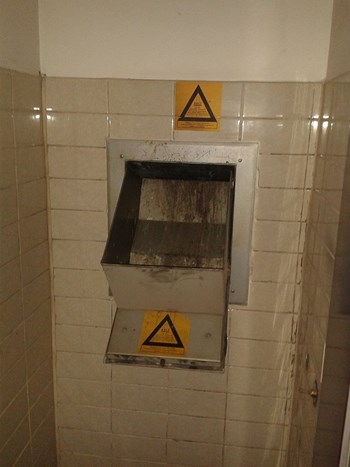
Anytime you have hundreds, or even thousands of people living in close quarters – in a multifamily co-op or condo building, say – certain challenges will inevitably arise. One of the bigger ones is how to maintain the flow of fresh, hygienic air into the building, and provide for the out-venting of stale air, fumes, and odors.
Poor air quality is at best a nuisance, and at worst a bona fide health hazard – so it’s crucial for boards and managers to stay on top of regular maintenance, take complaints about odors, fumes, and stale air seriously, and do what’s necessary to address them when they come wafting up.
Pinpoint the Cause
Pet odors, cooking smells, and secondhand smoke top the list of odor-related complaints in multifamily buildings and associations nationwide, but it’s not just about olfactory offenses – allergens and pathogens can also build up in vents and ducts, and in the worst case scenario, contribute to some very real health problems for people living in an affected building.
In its most extreme forms, poor indoor air quality can lead to what is known as “sick building syndrome.” While most often associated with commercial buildings, it can be a concern for residential dwellings too. The Environmental Protection Agency (EPA) defines sick building syndrome as ‘situations in which building occupants experience acute health and comfort effects that appear to be linked to time spent in a building, but no specific illness or cause can be identified.’ The problems may be felt in one particular room or area, or manifest themselves throughout the building.
This stands in contrast to ‘building-related illness,’ which, according to the EPA, is a diagnosable illness that can be identified and attributed directly to airborne building contaminants. “Sick building syndrome is absolutely a real thing,” says Mark Drozdov, Senior VP and Technical Director at BSI Services and Solutions Inc., an indoor environmental consulting firm based in New York City. “Some of the causes include mold, poor ventilation and low humidity levels.”
Oh, Chute
Taller multifamily buildings usually have a small room on each floor containing a hatch door that opens into a stainless steel garbage chute. The chute runs from the top floor all the way to a basement garbage room, where a dumpster or other receptacle is placed to catch residents’ bagged refuse as it tumbles out.
While a building’s rules and regulations typically lay out what can and cannot be thrown into the chute, residents will inevitably toss in unbagged, oversized, or especially gross garbage. This will eventually cause a blockage, which in turn can lead to a backup of putrefying trash piling up behind it. Throwing unbagged garbage down the chute causes also causes organic material to splatter and stick to the sides, coating the entire length in a layer of slimy, stinky crud that can attract pests and make the whole building smell like a landfill.
And of course, even when residents are super conscientious, trash bags do break occasionally – so no matter what, garbage chutes need regular attention and maintenance to keep them clean and odorless. That means management, staff, and residents must not only do their part, but be ready to bring in professionals to clean and sanitize the building’s chutes regularly in order to avoid bug and odor problems.
Keeping the Flow
If a building or association isn’t doing enough to maintain good air quality in the first place, odor issues can’t really be blamed on residents – even if they’re smoking stogies and sauteeing mushrooms in truffle oil every night. Proper installation and upkeep of HVAC systems have a huge impact on indoor air quality, and by extension on residents’ quality of life.
Ensuring proper ventilation can prevent the buildup of contaminants in buildings, says Casey Birmingham, senior project manager for The Falcon Group, an engineering and consulting firm based in New Jersey with offices in Connecticut and around the country. Those contaminants can include carbon dioxide, carbon monoxide, formaldehyde, lead, nitrogen dioxide, ozone, sulfur dioxide, humidity and microbial growth and the types of unpleasant odors that so often affect residents of multifamily buildings. “Ventilation is a central component of good air quality,” she continues. And too often that component can be forgotten, leading to stale air, allergens, odors and other problems for residents.
“While there are often minor complaints about odor transmission, the bigger issue is buildup of molds as well as water infiltration,” says Birmingham. Another common issue in buildings built from the 1960s to the present is that they typically have mechanical ventilation and it can over-exhaust. That means the building does not get the correct amount of outdoor makeup air to balance the air it vents out, creating draftiness, which manifests itself in whistling windows, doors or elevator shafts. This problem is further exacerbated by the “stack effect” experienced in tall buildings.
According to Birmingham, older buildings are not typically ventilated by mechanical equipment. Before the 1968 building code was implemented, buildings typically relied on natural venting through the opening and closing of windows and doors. And that can be a good thing. Gene Marckini, an associate with Boston-based environmental consulting firm Boston Environmental, agrees. “The type of air problems that can be caused by sealed homes...are wholly dependent on the construction of the home,” he says. “The older homes don’t matter much because they leak like a sieve and get lots of air movement, but newer [buildings] are very tight, and it can be a major problem if they don’t have a supplemental air supply.”
Begone, Stink
According to Maria Vizzi, president of Indoor Environmental Solutions (IES) in New York City, “If an air system is not working due to [something like] the obstruction of airflow in the duct/riser – really bad, offensive smells from cooking, bathrooms, or even the trash in the compactor room become trapped inside the building. If an air system is working well, then it will help transport the odors coming from the kitchens, bathrooms or common areas outside, and exchange air will have an opportunity to replace it.”
And the stench of poor ventilation goes beyond just being gross; breathing in garbage germs and airborne particles of pest waste is hazardous, and some kinds of mold have the potential to cause serious health issues – everything from allergic reactions to skin irritation, respiratory distress, even behavioral problems.
Of course, like a lot of things, stinkiness is subjective. What causes one person to gag may not even register with someone else. Fortunately, the professionals who specialize in handling problem odors have tools to help find, suppress, or eliminate them – including air-sampling equipment like respirable dust monitors and photo ionization detectors to measure airborne irritants and allergens, and field olfactometers that measure the relative strength of odors. They can also quantitatively determine if a smell qualifies as a nuisance, assigning a number value to the odor based on a set of standard metrics. When an odor is bad enough to be considered a nuisance, it can also become a legal matter – so this is good information to have!
When Vizzi’s company is engaged to investigate the cause of stale air or lingering odors in a building, they will first put a camera down into the ductwork to see if there is a blockage or obstruction. Sometimes they find interesting things, like construction debris left over from a resident’s renovation project, or other items that have accidentally tumbled into the system.
Sometimes it’s the renovation work itself that’s causing the problem. Vizzi says she’s seen situations in which her team’s cameras have revealed walls where there should be nothing but open airspace. “Respect the ducts!” Vizzi says. “There’s not always a good understanding of why the duct is there in the kitchen or bathroom. But it impacts that apartment and everyone on that line. It’s important to be conscientious of your neighbors.”
Drozdov agrees, adding that a full indoor air quality assessment is needed to see the whole picture of your building’s air quality, “including testing for humidity, air flow, mold, and volatile organic compounds, or VOCs.” VOCs can be found in paints, varnishes, wax, fuels and household products, and can be released both when they are in use, and to a lesser degree when they are stored.
According to Drozdov, air quality assessment is not really a do-it-yourself kind of job. “We recommend that this testing be done by professionals,” he adds, “only to prevent misinterpretations of data that could lead to wrong decisions.”
Because construction projects – either on-site or just nearby – can have such a huge impact on air quality, it is imperative that those projects be properly monitored, and any caustic or otherwise irritating materials and products be used correctly. For example, “Work with your construction team to make sure they’re using products with the least amount of VOCs,” says Doug Weinstein, Vice President of Project Management Group Inc., which has offices in New York City and in Florida. “And only use water-based polyurethane for floors. Otherwise, VOCs can get released into the air. ”
The same caution should be applied to the chemicals used in cleaning and building maintenance. “Make sure that all the material safety data sheets are on hand,” adds Weinstein. “They outline the uses for chemicals and show what kind of ventilation is necessary.”
All indoor environment pros agree that regular inspections and maintenance of building equipment and systems are crucial. The general consensus is that ventilation and other air-related equipment systems – as well as outdoor air intakes – should be looked at four times a year to check that components like fans, belts and so forth are operating properly. “With air quality, a lot of it is cleanliness of equipment,” says Weinstein. “Make sure the filters are changed and the machines are working optimally. Do a periodic cleaning of the ventilation shafts. Put it on a regular schedule.”
Keep it Moving
When it comes to ductwork, Vizzi says “It doesn’t get as much attention because people can’t see it. What you don’t see, though, can hurt you. It’s a matter of education. People need to understand that when they have stuff coming out of the grate in their kitchen, that’s not normal. You can have a $5 million apartment and still have stuff coming through that vent.” Regular cleaning is the best and easiest way to make sure that something like that does not happen.
And interestingly, just because you live in a newly-constructed high-rise rather than a century-old converted tenement doesn’t mean you’re guaranteed fresher, cleaner indoor air. “With prewar buildings, you actually have better ventilation because you can open the windows and control it,” says Vizzi. “You have more control over the environment and transfer of air.” With the more airtight construction of post-war residential buildings, “the air is more stagnant,” she says. “The building’s ventilation acts as the lungs of the building. If it’s not breathing properly, we have a problem.”
According to Birmingham, “People typically get professionals involved only when there’s a problem. They don’t realize the opportunities for energy savings and quality of life. If your building is over 10 years old and no one has addressed ventilation in the last decade, it should be looked at.”
For cooling and dehumidifying equipment, Birmingham suggests that building staff examine them in the early spring and early fall, as the moisture levels begin to change. “They should have it inspected and look for things like standing water in the condensate drain pan, and microbial growth in the evaporator coils,” he says.
Even if a building was operating at peak efficiency a couple of years back, it is important to go back regularly and check systems. “There are a lot of things that can impact ventilation,” says Birmingham. “Changing windows, changing space use, occupant habits. Air registers can get clogged. Dampers can break over time. You really need a combination of professional evaluation and regular maintenance.”
Making Improvements
If air quality issues are found within a building, it’s not the end of the world. “It can be a pretty easy thing to remediate some of these issues,” says Vizzi. Sometimes it’s just a matter of cleaning. Other times, it may be a matter of tweaking equipment to improve function and efficiency.
To improve air quality, buildings can “increase airflow, install vents in bathrooms, make sure that windows are sealed and winterized or glazed properly,” says Drozdov. “They can inspect the roof and façade periodically to ensure that no water intrusion is occurring.”
If bigger changes, including system upgrades, are needed, Birmingham says an engineer will be needed “to ensure you’re meeting all the standards in the mechanical code.”
And while major upgrades or changes may seem like a headache in terms of cost and time, they also may present an opportunity in terms of energy savings. For buildings that may have systems built on antiquated codes and regulations, “There’s huge potential for energy savings,” Birmingham says.
Ensuring that the air we breathe is clean, fresh and safe is one of the myriad responsibilities that boards and building managers must undertake on behalf of their residents and shareholders. Fortunately, with the right expert advice and testing, the task need not be too daunting. Ultimately, good air quality equates to good quality of life. Proper maintenance and diligence can ensure that everyone breathes easier.
Cooper Smith is a freelance writer and regular reporter for New England Condominium.






Leave a Comment